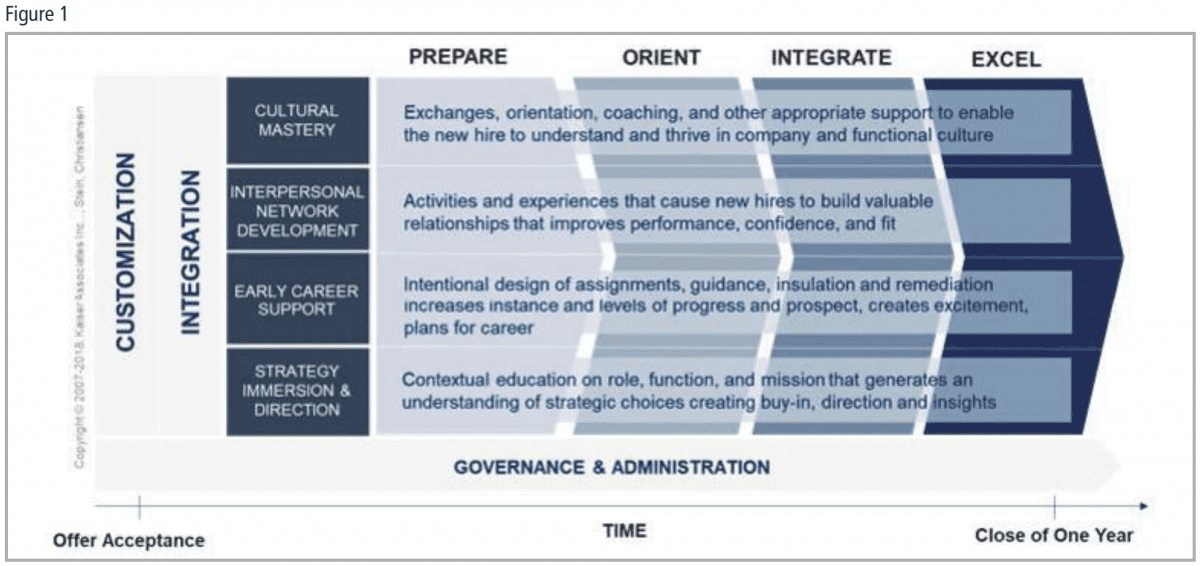How a cultural audit can elevate the onboarding process.
By Lilith Christiansen
Only 44 percent of employees believe their employer does a good job bringing new talent into the organization. Strategic onboarding seeks to solve that issue by moving beyond automating paperwork. Instead, it delivers a personalized journey that transforms new hires into fully functioning, integrated members of the team. Today’s onboarding approaches should provide clear expectations in terms of behavior and interaction with management, customers, and other employees.
Strategic onboarding is made up of four pillars: cultural mastery, interpersonal network development, early career support, and strategy immersion and direction (see Figure 1). Cultural mastery is a critical component, but one that often gets overlooked. Providing employees with a sense of formal and informal norms and how to thrive within them enables new hires to fit in quickly. New hires need to understand the ins and outs of company culture in honest and authentic ways, or else businesses risk losing them.
The challenge for many organizations is defining their culture. There are a few questions that can help start the process: What’s the “real and true” story? What’s changing as the organization grows and evolves? Are there any hidden perceptions that need to be unearthed? Are there any old traditions that need to be carried forward? Is the organization aspiring to build a different culture than exists today?
To find out the answers to these questions, organizations can execute a cultural audit. At its core, a cultural audit is a simple, three-step process that includes asking, documenting, and analyzing. Each of these three steps plays a critical role in understanding and establishing an organization’s culture.
- Ask. Conduct business leader interviews and use employee surveys and focus groups to get a sense of what all individuals across the entire organization feel are the core tenets of the company culture. Each level in the organization likely has a different take based on their day-to-day experiences.
- Document. Take the results of the surveys, focus groups, and interviews and document the corporate values, unconscious expectations, daily behaviors and practices, perceptions (even myths!), and anything of potential value that helps paint a picture of the culture.
- Analyze. Once the data has been collected and documented, examine it carefully to identify factors that are consistent as well as differences between sources. See if the data aligns with current strategies. Look closely to see if perceived, actual, stated, or desired cultures emerge. In particular, take note of areas where there is a disconnect between the aspirational culture and the way the organization currently functions.
By completing a cultural audit, organizations will get a firm sense of their culture -both where it excels and where it needs improvement.
Take Action
Learning and defining an organizational culture is the first step toward integrating cultural mastery into a strategic onboarding program. To bring the culture to life, organizations must demonstrate how it supports business strategy to positively impact outcomes. Some approaches:
- Short videos from current employees are a great way for new hires to get a real sense of the culture in an authentic way.
- Assigning a new hire a buddy at the peer level provides an opportunity for the new employee to learn the culture from a peer in an easy, low pressure way.
- Hosting a recent new hire panel discussion by bringing in two or three new hires who have been in the organization for between six and nine months is a good way to communicate actual experience.
- Provide managers with discussion prompts to talk about culture and even compare and contrast the company culture with the new hire’s former employer.
- Social events are also a good way to encourage opportunities for new hires and existing employees to get to know each other and share personal experiences that illustrate culture and the “unwritten rules” of the organization.
By knowing and communicating an authentic cultural story, new hires can plug into the true culture, helping them succeed and increasing the likelihood that they stay with the organization.
Lilith Christiansen is vice president of onboarding solutions for SilkRoad.















